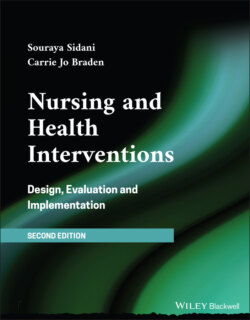Читать книгу Nursing and Health Interventions - Souraya Sidani - Страница 66
Review of Quantitative Studies
ОглавлениеQuantitative studies to include in the review are the ones that aimed to describe the health problem and/or to examine its relationships, direct or indirect, with its determinants and consequences within particular client populations and settings. The studies may use different research designs.
Results of descriptive cross‐sectional studies indicate the prevalence of the problem in different client populations and clarify the nature of the problem, its indicators, and level of severity as reported by clients presenting with diverse sociodemographic, cultural, and health or clinical characteristics, at one point in time. Differences in the health problem experience across client populations or subgroups of the same target population have implications for the design of interventions, whereby different components are selected or their delivery is adapted or tailored to variations in the clients' experience of the problem.
Results of descriptive longitudinal studies indicate changes in the experience, indicators, and severity levels of the health problem over time. Awareness of changes in the problem experience over time is informative as it guides the selection of the timing, within the health problem trajectory, for delivering the intervention; of the optimal dose at which the intervention is given which may incorporate “booster” sessions to prevent relapse; and the organization or sequence with which the intervention components are offered.
Results of correlational cross‐sectional studies support the existence, direction, and magnitude or size of the associations between the health problem, and its determinants. They shed light on the nature of the relationships (i.e. whether direct or indirect) between the problem and determinants. Findings of correlational longitudinal studies provide evidence of the sustainability or changes in the existence, direction, or magnitude of these relationships over time; they have the potential to identify the temporal sequence linking determinants to the problem, which is required to support naturally occurring causal linkages. For example, cross‐sectional evidence has long supported the existence of a positive correlation between insomnia and depression; but it was not clear which of these two problems caused the other. Recent longitudinal evidence suggests that insomnia predicts depression and that interventions addressing insomnia could contribute to improvement in depression and not the other way as implied in cross‐sectional evidence (e.g. Fernandez‐Mendoza et al., 2015).
